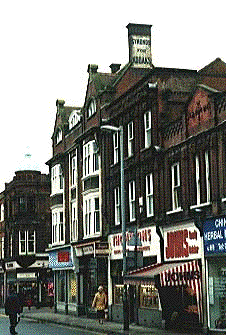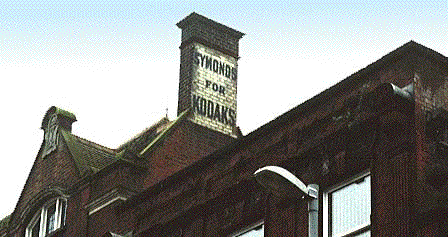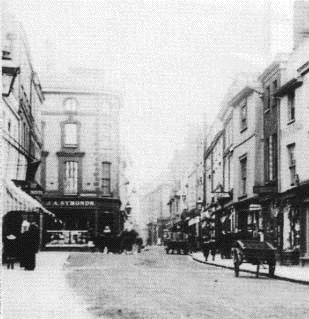Symonds For Kodaks
& Carr Street
The buildings at the corner of Buttermarket and (below)
Upper Brook
Street
have a chequered history. Before the latter road was widened in the
1930s,
J.A. Symonds' chemists shop (now an optician's premises) appeared in a
number
of period photographs. Such was the pressure on trading space in the
previous
century, it was not unknown for shops and stall holders to extend their
areas of operation into the street and over pedestrian paths. Streets,
already
narrow and crowded, became almost impassable at times. The shops on the
site shown below use to project several yards into the street.

The rather esoteric phraseology (see below* for an
explanation) of this
advertisment
'SYMONDS FOR KODAKS' was clearly designed to catch the eye of those
approaching
further up the hill of Upper Brook and Northgate Streets. Whether this
actually
worked is debatable given the plethora of high buildings which surround
it. We hope that the signwriter involved was on danger money during the
creation
of this sign...

Below: an unfamiliar view from around 1900 of the top
part of Upper
Brook
Street. The viewpoint is roughly from outside the present Wilkinsons
shop
and clearly shows the original Symonds chemists shop projecting into
the
street at the junction with Buttermarket. Other contemporary
views show the shop visible along Buttermarket creating a 'nip' in that
end of the street. In the 1860s the traders around this north-west
corner of Buttermarket 'had succeeded in inducing the Local Board of Health to vote £2,000
for the piece of land to be thrown into the street'. They bought
a number of properties on the north side and replaced them with a row
of 'good-looking white and red brick houses' [Malster in the Reading List]. This doesn't quite tie up with
the supposed date of 1900 for the period photograph below; one assumes
that the foreshortening of the buildings on the Buttermarket side would
have been done at the same time as the projecting buildings on the
Upper Brook Street side. Perhaps it took until after 1900, when
the photo is dated, to effect the demolition and rebuild of the
'good-looking buildings' which survive to the 21st Century. The
'Symonds for Kodaks' sign therefore probably dates from the first
decade of the 1900s.

Incidentally, more traces of chemist shop lettering can
be found at Hales Chemist (doorstep)
in St Helens
Street, E. Jowles in Fore Street
(frosted glass door) and in Felixstowe
Road.
Round the corner from the above view and to the right in Carr Street,
we
find another lost trading name from Ipswich's past emblazoned on a
high,
curving gable. 'SENNITT'S' sits above the present shop occupied by the
butchers,
Meat-Inn. Probably the subject of unsuccessful brick cleaning
operations,
the capitals are now grey and indistinct, but very big.
 -
-
The close-up is clearer (the final 'apostrophe S' less
distinct).
Next door to the Sennitt's lettering is a Subway fast food shop. Here
Carr Street has a much
smaller trade sign, brought to our attention by Mike O'Donovan. It is
so high up and so unremarkable, it's not surprising that this went
unnoticed for so long. Beneath
the redbrick swags and the reversed 'S' stretcher point is the metal
plate affixed by the company which constructed the building.
'ALFRED COE
BUILDER IPSWICH'
It's a humble little advertisement, but has certainly stood the test of
time. Anyone any idea when Alfred Coe was running his business in the
town?
 -
-
[Photographs courtesy Mike O'Donovan
- who must have a very keen eye, not to mention a good telephoto camera
lens]
*The origins and philology of 'Kodaks'
In 1883, George Eastman startled the photographic trade with the
announcement
of film in rolls, with the roll holder adaptable to nearly every plate
camera
on the market. With the "Kodak" camera in 1888, he put down the
foundation for making photography available to everyone.
The Kodak camera, pre-loaded with enough film for 100 exposures, could
be
easily carried and handheld during operation. It was priced at $25.
After
exposure, the whole camera was returned to Rochester, New Jersey,
U.S.A.
There the film was developed, prints were made and new film was
inserted:
all for $10.
So the sign on the chimney stack in Ipswich's Upper Brook Street:
'SYMONDS
FOR KODAKS' is essentially correct. If you want to buy a Kodak, visit
Symonds
shop! We think of the company, but they mean the product. A reverse but
similar transfer of name is 'Hoover' where the company name became a
generic
word meaning 'vacuum cleaner'. Excellent marketing.
The business started as the Eastman company, but added the name of its
most
successful product, to become Eastman Kodak in 1892. Asked about the
name,
George Eastman replied, 'Philologically, the word Kodak is as
meaningless
as a child's first "goo" - terse, abrupt to the point of rudeness,
literally bitten off by firm and unyielding consonants at both ends, it
snaps like a camera shutter in your face. What more would one ask!' The
camera proved such an enormous success that the word Kodak was
incorporated
into the company name.
(The Japanese electronics company Sony gained its invented name in the
1970s
for similar reasons: short, memorable and essentially meaningless
therefore
able to be marketed without bias and adverse connotation in any
language,
in any country.)
You can find more Carr Street lettering on our Co-op page.
Home
Copyright throughout this site belongs to Borin Van Loon, 2003.



 -
-
 -
-